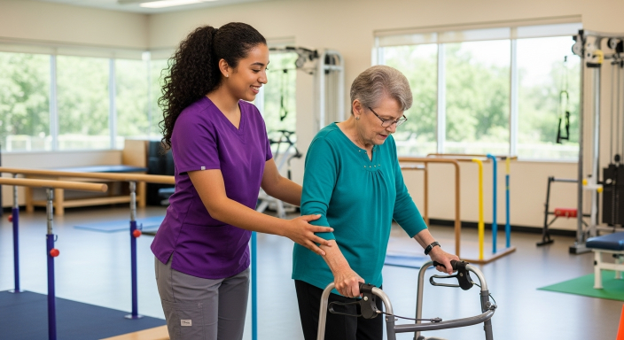Occupational Therapy Assistant Duties
Published - April 9, 2025


If you’re thinking about a career in healthcare, becoming an Occupational Therapy Assistant (OTA) can be highly rewarding. At CBD College, our OTA program prepares you to support Occupational Therapists (OTs) and help patients regain independence after illness or injury. If you are ready to become an OTA, we have you covered.
Occupational Therapy Assistant Duties: What to Expect
An occupational therapy assistant has many duties that help patients while also supporting the occupational therapy team. Some of their duties include:
Assisting with Patient Treatment Plans
OTAs are responsible for implementing the plan designed by the licensed Occupational Therapist. OTAs help patients do exercises, stretching and the important tasks that improve their daily life. For example, a stroke survivor may need to relearn how to hold utensils. The OTA sets up short sessions focused on gripping, lifting, and moving objects.
Guiding Patients Through Therapeutic Activities
Many therapy sessions involve practical activities that train the patient’s body and brain. OTAs guide patients through these tasks. A child with ADHD may struggle with focus and hand control. An OTA might create a fun game using colorful blocks. The child follows a pattern while practicing self-control and attention to detail.
Teaching Use of Adaptive Equipment
OTAs train patients to use tools that make their everyday lives easier. These tools can be simple, like a sock aid, or complex, like a mobility scooter. The OTA ensures the patient understands how to use them safely. For example, a man recovering from hip surgery can’t bend down to put on socks. The OTA shows him how to use a long-handled shoehorn.
Monitoring and Reporting Progress
Tracking patient progress is an important part of the job. OTAs write notes after every session to help the occupational therapist decide whether to update the treatment plan. After two weeks of therapy, the OTA notices that a senior with arthritis can now cook a basic meal using adaptive tools. The OTA records the improvement and shares it with the OT.
Supporting Mental and Emotional Health
OTAs help patients stay positive and engaged, by offering emotional support and creating routines that help build self-esteem and reduce stress. For example, a teenager recovering from a car accident may feel discouraged. The OTA starts by building trust through casual conversation. They work on setting small goals, like brushing teeth independently or walking across the room with a walker. Before they know it, the teenager is performing many daily tasks.
Educating Patients and Families
OTAs teach caregivers how to support patients between sessions. They explain how to safely help with daily tasks and how to avoid setbacks. A parent learning to care for a child with cerebral palsy might not know how to assist without causing pain. The OTA will demonstrate how to move the child gently and explains which exercises should be done at home to maintain progress.
Setting Up and Organizing Therapy Sessions
Before each session, OTAs prepare the therapy space, to ensure the environment is safe. For a patient relearning fine motor skills, the OTA may arrange a therapy area with easy-to-grasp tools, such as therapy putty or grip trainers.
Documenting Patient Records
Every OTA keeps accurate, detailed session records to track exercises done, patient performance, behavioral changes, and safety concerns. Documentation also helps with billing and meeting legal requirements. If a patient with dementia shows signs of confusion or new behaviors during a session, the OTA documents everything clearly so the rest of the care team can adjust treatment.
Helping Patients Regain Independence
An important goal of occupational therapy is to help patients become as independent as possible. OTAs help patients practice skills needed for self-care, school, work, or home life. For example, a woman recovering from hand surgery may struggle to type. The OTA sets up typing drills and introduces ergonomic tools.
Adapting Activities Based on Patient Needs
OTAs often modify activities based on pain levels or attention span. They know how to shift plans without losing progress. A child with sensory issues becomes overwhelmed during group therapy. The OTA can bring the child into a quiet space and switches to a calming solo activity.
Working in Different Care Settings
OTAs work in hospitals, rehab centers, clinics, schools, and homes. Each location comes with different patient needs and challenges. In a school, an OTA may help a student with autism stay focused in class by creating a sensory-friendly workspace. In a home care setting, the same OTA may work with a stroke survivor to safely climb stairs or prepare meals.
Communicating with the Therapy Team
OTAs are part of a larger care team. They regularly update the occupational therapist and may coordinate with other members of the therapy team. For example, if a patient starts to show signs of depression, the OTA shares this concern with the OT. The OT may then consult with the care team to adjust the therapy plan.
Encouraging Patient Participation
OTAs find creative ways to help patients stay active in their recovery, even when progress is slow or therapy is tough. An OTA knows that a patient with a spinal cord injury loves cooking. They can design therapy around kitchen tasks, turning a personal interest into a way to build strength and fine motor control.
Practicing Safety and Infection Control
OTAs follow strict health rules to protect patients. They are responsible for cleaning tools, wearing protective gear, and following care protocols. In a rehab unit, the OTA wears gloves while assisting a patient with wounds. After the session, they clean and store all equipment to prevent infection.
Supporting End-of-Life Care
In hospice settings, OTAs focus on comfort and dignity. They help patients enjoy meaningful activities and support emotional needs. An OTA visits a patient with cancer who loved painting. Even though the patient has limited movement, the OTA can set up a modified canvas and help them create simple artwork, offering peace and joy.
Final Thoughts
Occupational Therapy Assistants improve patients’ lives. They help people live with greater purpose every day. Through hands-on care, OTAs play a critical role in health care for patients in their communities. If you’re looking for a healthcare career that is both challenging and rewarding, becoming an OTA might be the right path for you.=
OTA School Program
You’re already making a difference through the work you love. Now, take it to the next level with the Occupational Therapist Assistant program from CBD College. It’s flexible, affordable, and uniquely tailored to build on the skills and experience you’ve acquired professionally.
Contact us now to learn more.
